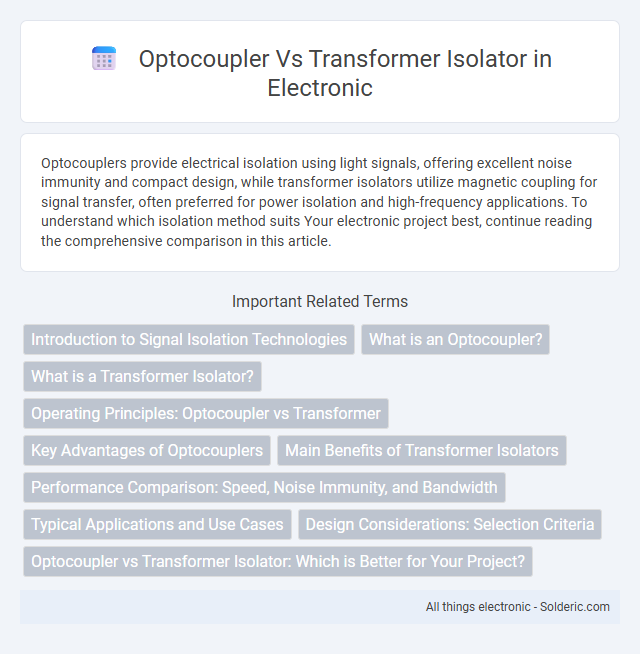Optocouplers provide electrical isolation using light signals, offering excellent noise immunity and compact design, while transformer isolators utilize magnetic coupling for signal transfer, often preferred for power isolation and high-frequency applications. To understand which isolation method suits Your electronic project best, continue reading the comprehensive comparison in this article.
Comparison Table
| Feature | Optocoupler | Transformer Isolator |
|---|---|---|
| Isolation Method | Light transmission through LED and photodetector | Magnetic induction via transformer windings |
| Galvanic Isolation Voltage | Typically up to 5 kV | Up to tens of kV, depending on design |
| Signal Type | Digital or low-frequency analog signals | AC signals, power, and high-frequency signals |
| Frequency Response | Up to a few MHz | Can support high-frequency signals up to GHz |
| Power Isolation | No power transfer, signal only | Supports power transfer and isolation |
| Size | Compact and PCB mountable | Usually larger due to transformer core |
| Applications | Signal isolation, microcontroller interfacing | Power supplies, signal isolation, impedance matching |
| Cost | Generally low cost | Higher cost due to materials and size |
| Linearity | Limited linearity, non-linear behavior | Good linearity for analog signals |
| Lifetime | LED degradation limits life | Longer life, mechanical wear minimal |
Introduction to Signal Isolation Technologies
Signal isolation technologies are essential for preventing ground loops and protecting circuits by electrically separating input and output signals. Optocouplers use light to transfer signals across an isolation barrier, providing high-speed response and low power consumption. Transformer isolators leverage magnetic coupling to transfer signals, offering robust noise immunity and the ability to handle higher power levels in applications like industrial systems.
What is an Optocoupler?
An optocoupler is a semiconductor device that transfers electrical signals between two isolated circuits using light, providing high-voltage isolation and noise immunity. It consists of an LED and a phototransistor enclosed in a single package, enabling signal transmission without direct electrical connection. Your choice between an optocoupler and a transformer isolator depends on factors like signal frequency, isolation voltage, and application requirements.
What is a Transformer Isolator?
A transformer isolator is an electrical device designed to transfer electrical energy between two or more circuits through electromagnetic induction, providing galvanic isolation to prevent direct current flow and protect your equipment from voltage spikes and noise. Unlike optocouplers that use light to transfer signals, transformer isolators rely on magnetic fields within coils to ensure signal integrity and reduce electromagnetic interference. This isolation is critical in power supplies, audio applications, and communication systems to maintain signal quality and safety.
Operating Principles: Optocoupler vs Transformer
Optocouplers operate using light signals to transfer electrical isolation between input and output, typically employing an LED and phototransistor, which ensures minimal noise and high-speed isolation in low-voltage applications. Transformer isolators rely on magnetic induction through coils wrapped around a core to transfer energy, providing robust isolation and the ability to handle higher power and voltage levels. Your choice between these devices depends on the required isolation voltage, frequency response, and the application's power demands.
Key Advantages of Optocouplers
Optocouplers provide superior electrical isolation by using light to transfer signals, eliminating direct electrical connections and reducing noise interference. They enable compact designs with low power consumption and high-speed signal transmission, making them ideal for sensitive or high-frequency applications. Your circuits benefit from enhanced safety and reliable data integrity, especially in environments with high voltage differences.
Main Benefits of Transformer Isolators
Transformer isolators provide robust galvanic isolation with high voltage withstand capability, ensuring enhanced safety in electrical circuits by preventing direct current flow between input and output. They offer superior noise reduction and signal integrity, especially in high-frequency and power applications, due to magnetic coupling rather than semiconductor-based components. Their durability and ability to handle high power levels make them ideal for industrial environments requiring reliable isolation and minimal signal distortion.
Performance Comparison: Speed, Noise Immunity, and Bandwidth
Optocouplers offer high noise immunity and excellent electrical isolation but typically have slower switching speeds and limited bandwidth compared to transformer isolators. Transformer isolators provide superior speed and wider bandwidth, making them ideal for high-frequency applications, while maintaining moderate noise immunity. Your choice depends on whether performance priorities lean towards rapid signal transmission or robust noise rejection.
Typical Applications and Use Cases
Optocouplers are commonly used in digital signal isolation, microcontroller interfaces, and noise reduction in communication systems due to their fast response and compact size. Transformer isolators excel in power transfer, audio signal isolation, and high-voltage applications requiring galvanic isolation and robust electrical separation. Both are essential in industrial automation, medical devices, and instrumentation but differ significantly in bandwidth, isolation voltage, and application environments.
Design Considerations: Selection Criteria
When selecting between an optocoupler and a transformer isolator, key design considerations include voltage isolation requirements, signal frequency, and power consumption. Optocouplers are ideal for low-frequency, low-power applications with high electrical isolation, while transformer isolators excel in high-frequency, high-power signal transmission. Your choice should prioritize isolation voltage, signal integrity, and compatibility with the system's operating environment.
Optocoupler vs Transformer Isolator: Which is Better for Your Project?
Optocouplers provide electrical isolation and signal transfer using light, offering faster response times and lower power consumption compared to transformer isolators, which rely on magnetic coupling for isolation. Transformer isolators excel in handling high-voltage isolation and power transfer in AC signals but typically have larger size and slower response. Your choice depends on whether your project prioritizes high-frequency signal isolation with compact components (optocoupler) or robust power isolation in high-voltage environments (transformer isolator).
Optocoupler vs transformer isolator Infographic

 solderic.com
solderic.com